Neck Sharpies: The Don Brown Defensive Glossary: 3-4 Edition

[Photo: Upchurch]
Last week we introduced the defensive terminology for Don Brown's base defense and his 4-lineman sub packages. Quick clicky-popup diagrams of the 4-3 and 4-2-5 forms we covered:
This week I'd like to get into the 3-4 and 3-3-5 and 3-2-6 looks, or in Brown's terminology, the "50" formations.
-------------------------------
SO WHAT DOES THE 3-4 LOOK LOOK LIKE?
The BC defense Brown brought over is a base 4-3 and 4-2-5 nickel, and they'll run a relatively small suite of plays from that base on most downs. But a lot of the fancy stuff—truly, most of the playbook—are out of what are usually called "30" and Brown refers to as the "50" fronts*, i.e. formations with three defensive linemen.
Here's the basic version, as taken directly from the 2013 Boston College playbook that James Light posted.
Technically, the "Tackle" (Hurst's position) has been replaced with a "Backer" (B). When you hear about a guy you thought was playing defensive end being called a "linebacker" (e.g. Kemp) it's possible he's playing the Backer position. If a dude's getting mentions as an "OLB" that's also a sign they're using him in that Backer/Sam role, where "Sam" means "Jake Ryan-esque."
That isn't anybody yet—I've been using Winovich as a placeholder—but the ideal here is clearly LaMarr Woodley: a 6'2/260-ish, athletic, stand-up, high-burst, space-tackling, strong-enough-to-stand-up-to-blocks attacker who can play rush end or cover some. That last is notable because it gives the 50 formations a suite of tactics that are generally absent from Brown's 70 formations: zone blitzes.
* [It's 50 and not 30 because look at the pic above and count the guys on the line. Now think back to that ol' Schembechler 5-2 "angle" defense. The more things change…
[After THE JUMP: bandits, canidae, diagrams that look like they're saying "Mike Gedeon" and "Will McCray", and blitzes. Oh lawdy do we got blitzes.]
What's different from the 70 fronts? The Backer for one. Having a guy who's 75% rush end out there puts pressure on the backside of the pass protection. Imagine the left tackle swinging wider to get the Backer; the guard is now 1-on-1 with the end. Just as spreading the offense puts more guys in battles in space, spreading the front gives your DL more space to leverage blockers, stressing the tackle-like properties of the guards.
But your linebackers had better be good at getting to their gaps. The Will is also less protected from blocks—both the MLB and the WLB have to deal with free-releasing guards on downhill runs.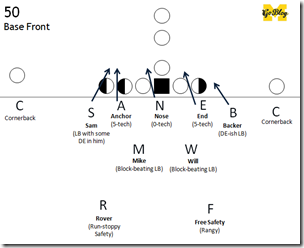
The 3-4 alignment makes the Anchor more like the 5-tech from the Under era, where he'll have to gum up the works by standing up to TE/OT doubles but doesn't have to prevent that TE from going out.
The Sam picks up those TE duties, and can be a Jake Ryan-esque player (not that different from the Backer). However as we'll see, the Sam tends to get lifted often for a hybrid guy. Personnel-wise a base 50 call would probably see Winovich in for Hurst and perhaps Gary stealing some snaps at end. Against a heavy running team, maybe Furbush or some other heavier linebackery object will be in at Sam, with Peppers moved to safety or corner. But again, the way Brown uses his 50 formations the base is not actually what we'll see the most often.
Some of the typical gap assignments are different. The nose is more likely to get into the strongside A gap rather than the weakside one, which is now covered by the Will; the End has shifted into that backside B gap. In general it's a bit stronger formation for stopping outside runs, with a bit of weakness in the department of backside downhill runs. Unless you've got a rampant DL, an offense can do a lot of damage to a too-predictable one-gapping 3-4 with backside cuts, traps, and counters.
What's not different? The nose, despite lining up right over the center, is not two-gapping. Brown does have some two-gap stuff but he tends to do that out of every formation with the end; the Will then picks whatever side of the End's blocker that the End doesn't isn't in. So spiritually this 3-4 is still functioning like a 4-3, i.e. it's a gap defense, albeit one that does some very 3-4ish things like blow offensive players off the line at the snap instead of just blowing by them.
-------------------------------
HYBRID POSITIONS: 50 (three defensive linemen) FRONTS
Just looking through the BC playbook you get the sense that the 50 fronts really exist more for the hybridization opportunities. That's a departure from the 70 fronts, where the personnel/job changes are extensions of a true down-to-down base defense. This means you're probably not going to see the base 3-4 all that much; it's just a starting point for what I imagine will be a bunch of nickel and dime packages that Michigan will trot out against specific opponents.
For example, BC spent most of its game against Brian Kelly's spread-to-pass Notre Dame in the "Dog" defense, which is the 50 front with an extra safety in the middle of the defense instead of the Backer. Bandit seems to come out against spread-to-run teams; Pup is common against dink 'n dunk passing teams.
I've split them into two categories: 1) The Base 3-4 + Nickels, and 2) Dimes/Pure pass pro forms.
-------------------------------
NICKEL/BASE 3-4 PACKAGES
Bandit (BA). A hybrid space guy replaces the Sam, and the borrowed 3-3-5 terminology should clue you into what kind of defense this winds up being:
If you remember your 3-3-5 positions from the gawd awful late Rich Rod period, you'll remember Kovacs deployed exactly as I have Peppers above. In Brown's defense the Bandit seems to mostly be a man-to-man cover guy who follows #2 (counting outside to inside) receiver wherever he goes.
I've got Peppers in the eponymous role, but it's just as (if not more) likely that Delano Hill plays the Bandit job while Peppers goes to Rover, which is doing the things that Peppers usually does at Sam. Brown always has the Anchor and the Rover to strength, so this is just a name thing. To go way back to our Rocky Long talks from 2009, Rover in this formation is the "meat raw" flat defender while the Bandit is the "tackles in space" one.
The Backer (B), is basically in the position we tried to get named "Deathbacker", that they tried to make Roh play until he had to beg to go back to End. The Backer is blitzing often, though there are some crazy Bandit formations with all sorts of guys (and dudes) blitzing.
Here's a Bandit page out of the playbook where it's the same play (a Cover 1 WLB A-gap blitz) against various spread offense looks:
With Peppers already out there Michigan can go to a Bandit from their base formation by lifting Hurst or another DL for Winovich.
Pup (P). A hybrid space player replaces the Backer.
Pup is basically the flipside of Bandit, and it's all over the playbook, with the Pup often blitzing. Seriously, most of the last third of the playbook is just nefarious Pup blitzes, including one where he's standing around in the middle of the field making noises like he has no idea what's going on, then right before the snap he creeps right down the center and blitzes an A gap.
And that makes sense since you've taken what's normally your top pass rusher off the field for the Pup, and nobody likes a quarterback standing around all bowels intact-y. If Bandit is the 3-3-5, the Pup formations are really a 3-4 that has traded in some of the weakside OLB's pass rushing for more ways to confuse the protection.
The Pup also has base Cover 1/Cover 3 things: covering the "box" (middle) zone, buzzing the flat then dropping into a hitch zone, backing out into the deep overhang zone, taking a slot receiver in man-to-man, etc.
The Sam meanwhile is exactly the "Sam" of 2012, when Michigan would line Jake Ryan up in nickel formations as a quasi-defensive end, then rush the quarterback or stunt around on a blitz. Considering this roster's dearth of proven pass rush terrors, its wealth of multi-purpose 0- to 5-tech DL types, and a Peppers who can do all the things, I suspect we'll see plenty of Pup this year.
Cheetah (E2). Remember Shawn Crable? Remember Pierre Woods? Remember those guys were these scary, skinny knives who were terrifying as pass rushers but pushovers if a tackle run-blocked on them? They're legion. They've got no wiggle so they can't cover like linebackers, and not nearly enough heft to be every down ends, but you recruited them just in case one or two of those things might develop and all that giddyup could be unleashed.
Well Brown found a use for those too. A Cheetah is a second end who replaces the Backer. Which if the Backer is basically a DE anyway that could just mean the Backer has his hand in the dirt. Or it could mean Lawrence Marshall will accrue 5.5 sacks in limited duty in 2016.
What it usually means in this playbook is they're playing games with the DL. Above I have Marshall. But they could also use the Pup personnel and Peppers could be the Cheetah. Or if they have a young DE who can blitz but can't yet hold up to blocks they can use him here.
You'll note the above diagram has the defense in an Okie. They have another package from Cheetah where the Nose is in a 3-tech and two LBs are up on the line and then all sorts of havoc happens on the front while the secondary plays an MSU quarters coverage. They call it "Spartan."
Spartan is one of the few plays that the E2 is actually an outside pass rusher. Quite often he's looping inside to essentially blitz an interior gap, probably because if you get caught with a smaller guy defending the edge of a running play you're gonna have a bad time. He's…okay, seriously person on a Michigan blog, let's stop pretending you need to be told what a Cheetah is after you read "Remember Shawn Crable?".
-------------------------------
DIME PACKAGES:
Dog (D) A coverage guy replaces the Backer.
This is a cover 3-3-5 or 3-3-5 umbrella, emphasis on the three safeties thing. But it's not a 3-3-5 like you're used to. Like, they line up the Dog in the middle, as if there's three safeties.
So yeah this is a personnel group for when the offense is throwing out a ton of receivers and sending them all over the field. The MLB is a common blitzer while the outside linebackers are playing wide zones and the DL have a ton of stunt schemes. The Dog is also a regular blitzer from anywhere and everywhere. There's also a lot of pre-snap motion or weird out-of-position things like the Will re-routing a slot receiver out of his break.
They can also go to Dog from their Pup personnel by having Winovich line up as Sam and Peppers be the Dog. I think we'll see more of that nickel version of Dog than the real thing. We'll also see Michigan bringing in the next generation of safeties to get some snaps in this package (I've got Dymonte at Dog and Kinnel at Free above).
Greyhound (Backer—>Bandit, Sam—>Dog) is technically the 3-2-6 dime package. In theory the 3-4 outside linebackers (the Backer and the Sam) are out for hybrid coverage guys, the Bandit and the Dog, respectively. In practice it's the same exact thing as Dog because Peppers. In fact, our every down Sam is our Bandit and often our Dog. It gets more confusing because the Greyhound formations in the book often have the Sam in and the Will out instead—it's really about which one of those guys you'd rather leave on the field.
So yeah, the difference between this and Dog is the Sam or Will comes out for yet another safety-ish cover guy. But since Peppers is already a cover guy, for Michigan the difference is crayonic.
Nickel Sam (NS) and Nickel Sam Pup. Another round of specializations that don't mean as much with Peppers able to transform into a coverage player. However this does create a different look since Brown really means an old fashioned "nickel"—i.e. a third cornerback. Simply put, the Dog and Greyhound formations will pull outside linebackers for more safeties, while Nickel Sam is putting a cornerback out there to just cover.
So if Lewis, Stribling, and Clark are on the field at the same time, one of them will probably line up over a slot receiver, and that guy is the "Nickel Sam." As for Nickel Sam Pup, that just means the Backer has been replaced with the Pup.
You can see the DL here are not even pretending to care if it's a run. The nose is gonna loop over to the A gaps and hopefully occupy the center and guards while his end buddies isolate the tackles. Another weird thing is the "Will" (the W is for weak) inside linebacker is antonymically playing strong- and out- sides.
That's because the Sam was lifted for the Nickel Sam, who is just going to follow the slot receiver wherever and play cornerback on him. But there's still linebacker work to be done. So the Will does the things he normally does: play off an end, cover a second level zone, and get depth if he's not being attacked. Call him the Sam if you want (or use the Sam if you want). Just like how the guy on offense who's taking the snap then passing or handing off is still called the "quarterback" even though no team actually lines him up in his rugby position*, the title follows the work, and that's the basis behind Brown's terminology.
-------------------------------
*[The name is not from the Wing T formation but from the game's rugby-like origins. In rugby** the position that shares a last common ancestor with football's quarterback is what's now called the "scrumhalf"—the guy who squats behind a scrum and then pitches it to one of several backs at various depths (half-, full-, etc.) from the line of scrummage behind him.]
**[Rugby League and Rugby Union† split several decades after American football went down its own path, so it applies to both.]
† [What's the difference? Think of Union as the college football except their version of the NCAA was able to prevent the NFL from ever forming, while maintaining the pretense of amateurism until 1995(!). For Rugby League, imagine if 100 years ago some Appalachian schools were like "Screw you guys; we're paying our players," then created the Arena League.
March 29th, 2016 at 12:13 PM ^
This week I'd like to get into the 3-4 and 3-3-5 and 3-2-5 looks, or in Brown's terminology, the "50" formations.
We bringing back Ferrigno as an assistant on defense?
March 29th, 2016 at 12:21 PM ^
It is the "Dude" formation where we decalre, "we are so much better than you we only need 10 people!"
March 29th, 2016 at 12:24 PM ^
Is only used after a red card.
Sent from MGoBlog HD for iPhone & iPad
March 29th, 2016 at 12:18 PM ^
needs moar pepperbacker
March 29th, 2016 at 12:23 PM ^
made me chuckle
March 29th, 2016 at 12:27 PM ^
Maybe its because this is one of the few times I've seen a defense explained in this detail (Thanks!!), but this D sounds really complicated. I'm glad Michigan has some easy-ish games to start the season and get some live reps.
But it's unlikely they will bring the entire playbook each week. They will bring some subset of plays based on their scouting for each game. The installation in spring and fall camp allow them to prep a smaller set of plays week-to-week. But the intention isn't likely to allow them to run the entire playbook at any time, because that becomes overwelming for the players.
March 29th, 2016 at 12:40 PM ^
I like the Schembechler 5-2 "angle" picture:
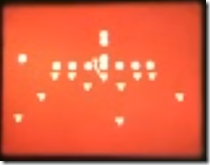
Even embiggened it's fuzzy! :-)
Question -- back in the 1970's I remember Bob Ufer referring to Don Dufek as "The Wolfman" position. I'm guessing that was a free safety type. Any idea how that concept from back then might map to Brown's scheme?
March 29th, 2016 at 12:57 PM ^
Bo's Wolf was the Strong Safety position. In that 5-2 angle defense pic the Wolf is the safety hanging out off the strong side (left) at about linebacker depth. As you can see he's got linebacker and safety responsibilities. The other safety ranged deep. I don't know what Bo called it but I read a thing once that Miami post-Bo called it the "Dog" safety.
March 29th, 2016 at 12:39 PM ^
Having a guy who's 75% rush end out there puts pressure on the backside of the pass protection. Imagine the left tackle swinging wider to get the Backer; the guard is now 1-on-1 with the end. Just as spreading the offense puts more guys in battles in space, spreading the front gives your DL more space to leverage blockers, stressing the tackle-like properties of the guards.
But your linebackers had better be good at getting to their gaps. The Will is also less protected from blocks—both the MLB and the WLB have to deal with free-releasing guards on downhill runs.
Easier said than done. Is that enough meat in the middle? I'm guessing these are mostly for passing downs to finish off drives, because I do have a concern -- we're setting up the down linemen awfully wide so yeah, the ILBs have to eat guards. . . but Brown likes his linebackers small and quick. I can see OSU show a pass look on 3rd and 9, audible into an inside run, sustain a double on the NT, one of the ILBs eats a guard, rest of the OL has inside leverage, RB gets the blitzer/free hitter and the QB just runs for a first down. The linebackers are physically overmatched so despite being a one-gap defense this looks like a lot of pressure on the NT, unless the safety is dangerously aggressive.
Yes, that sometimes leaves you out of position, but the goal is to confuse the blocking scheme up front so that someone busts, and also so that players can go directly to their gap without having the read and react.
Brown's philosophy is "Solve your problems with aggression." If we're a bit short on meat, we make up for it by getting in those gaps quickly.
Sounds more break-or-bust. More TFLs, but more risk of getting burned. But it's not like a read-and-react defense is inherently better, and I expect the DC for last season's #1 defense to be judicious with his blitzes.
In principle, I'm OK with fewer shutouts if it means we have a better chance of throwing spread-to-run offenses off balance.
March 29th, 2016 at 12:43 PM ^
And please feel free to put the link to wherever this has been said before (if necessary):
What is the basis for the terminology as regards the numbers - 50, 51, 52, etc.?
Are they specifically significant to the personnel groupings a/o formation? How so?
Thanks!
"50" and "70" are the base personnel groupings. From what I can tell "50" means the exact same as "3-4" and "70" means "4-3".
From there they have slightly different FRONTS, numbered 1, 2, 3, 4, etc. So "51" means 3-4, Front #1, "72" means 4-3, Front #2, etc. Those numbers may correspond to the technique of the nose. The fronts are how they align against the offensive line, and will mean slightly different responsibilities.
But Brown is using it as "first number is formation type", second number is the technique of the first DL to the backside of the play.
So 70(s) is a 4-3 Over. 50(s) is a One-Gap 3-4 with a Nose over the Center. 20/80(s) are typically even fronts where the center isn't covered by a DL or a LB. 40 may be an Under front, or it may be .
So...
71 is a 4-3 Over with the backside DT in a 1-Tech.
72 is a 4-3 Over with a backside DT in a 2-Tech
50 is a 3-4 with the NT lined up heads up on the C
52 would be a weakside shift of the 3-4.
54 would be a strongside shift of the 3-4 (the NT would shift to the strongside, the first DL to the weakside would be in a 4-tech).
Etc.
But again, this is handled differently for different systems.
An example from the Lloyd Carr days
20s = LBs are split (2nd number is backside DT); ex. 4-2-5 nickel
30s = DL lined up over Center and both Guards; LBs split (second number is alignment of strongside End); example Bear front
40s = 4-3 Over (2nd number is backside DT position); example, 4-3 Over
70s = NT over Center, next DL over tackles with LBs split (50 front above).
80s = 4-3 Under (2nd number is frontside DT technique).
But in conclusion, it's just a way of establishing a front and a basic technique in that front. You can use other words (tags) to further adjust the front, for example Over 21 which will shift both DTs into an over position (with the assumption that a 20 front is an even front, with both DTs nominally playing a 2-tech). Over 21 would push the backside DT into a 1-tech and the frontside DT into a 3-tech.
This is very helpful. If only Doc Brown could get a time machine so we could bring back Sam Sword and Clint Copenhaver (along with Keith Jackson to announce those names)
Didn't know other coaches could sport the thin M. I guess only Dudes can.
Michigan has pretty much always been a multiple defense, with the exception of last year to an extent. Multiple in coverage and multiple in defensive fronts. Yes, even last year's defense featured some of that, but to a much lesser extent (they were more similar to MSU in this way).
What you'll notice from above though is multiple personnel groupings, but a lot of them are, for the most part, allowing for the same personnel if need be. This makes it so the sub packages are easy (essentially one player in, one player out, the others just playing their position), but difficult for the offense to get a grip on. They'll all have some similarities in coverage and such, but Brown gives the defense a lot of options.
Now, as I described above, most likely, they are only bringing a subset of these players week-to-week. But the installation allows them to be very multiple, even within game (for example, Mattison was multiple, but he'd play Cover 4 vs Northwestern and Cover 3 against MSU, or more along those lines, where he wasn't very multiple in game, but was week-to-week). Brown likely to be multiple in game, thus confusing the opponent play-to-play (rather than just forcing the opponent to prep for every defense). But he won't do all of these things in any one game. He'll scout the opponent, see what he likes to run against them based on that scouting, and bring that to the game each week.
This is really good stuff Seth. It shows just how multiple Michigan can be, which makes life fairly tricky for opponents trying to guess what they'll see next (and Brown loves late movement, making it difficult to audible into the correct play; instead, the opponent needs to make the reads right before or during the play).
It sounds very much like the perfect counterpart to the offense.
I think offenses will try to tempo Brown to negate the pre-snap movement.
Is the End Taco the one you eat right before your colon blows?
It's the one at the end of the bag/box/basket that you reach for after you've eaten all the others. It's drenched in the oil drippings from the other tacos laid on top of it, so taking it out makes a mess on your hands and significantly reduces the weight of the bag. A greased lightening, if you will.
And they only did that when the opponent put two guys in motion (thus not allowing them to snap the ball as the defense shifted). That was a stop-gap move by them, so that certain players could improve at a certain position and not have to learn more things, but it stopped I believe the next year.
So Brown will do what he feels is necessary for the defense to perform. With the skill up front, I doubt he flips the defense, and will generally probably just bump guys over and shift the LBs and safeties to account for the strength of the offense. The Rover should be able to handle much of the same duties as the Bandit, the End should be able to handle much of the same duties as the Anchor. Or the Bandit may just follow the motion across the formation, etc, depending on the coverage. They may have autochecks to change the defense in those situations (motion from the slot is an auto blitz from the Bandit). Etc.
March 29th, 2016 at 10:09 PM ^
I thought I understood football defensive alignment and responsibility until I read this breakdown. Great job!
Sent from MGoBlog HD for iPhone & iPad
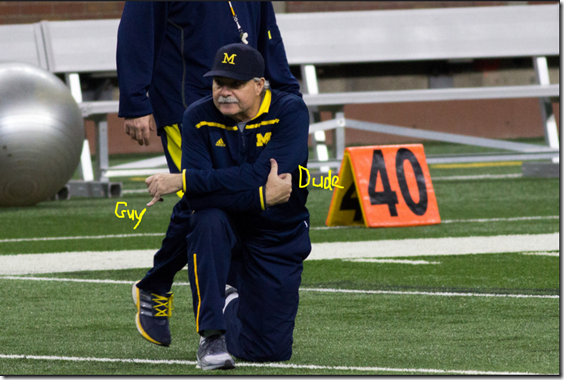
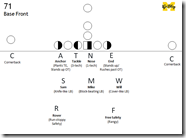
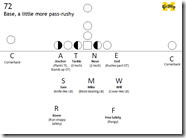
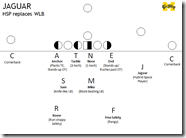

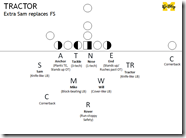

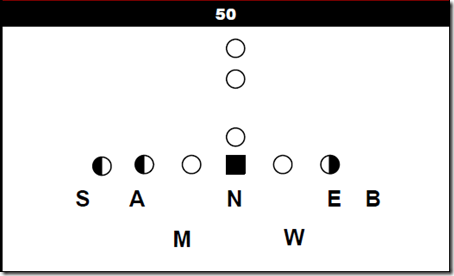

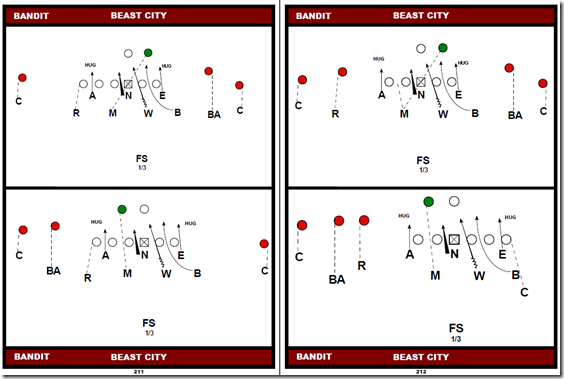

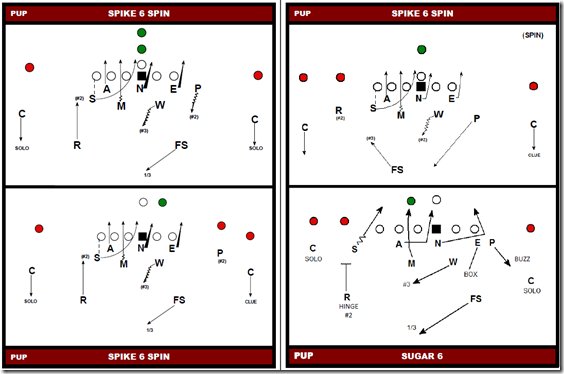

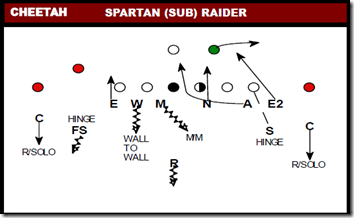
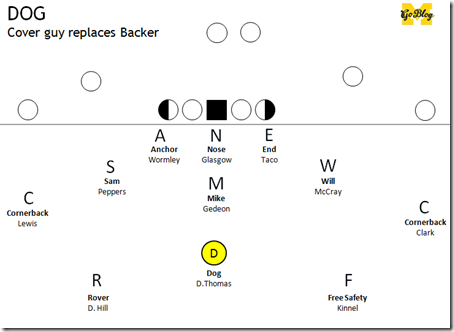
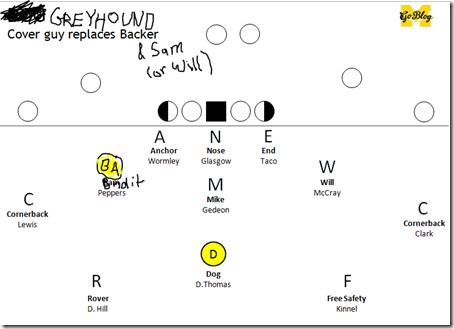
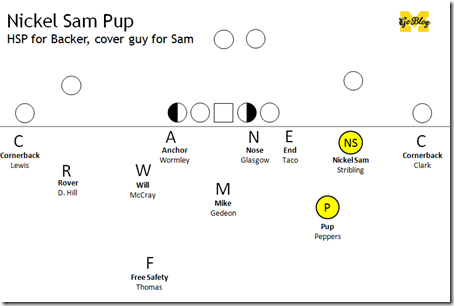

Comments